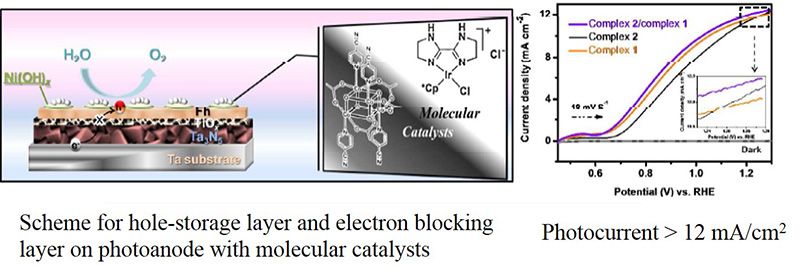Photoelectrochemical (PEC) water splitting is an ideal approach for renewable solar fuel production. The feasibility of PEC water-splitting cells relies on the development of high-performance photoanodes. Significant progresses have been made in the discovery of narrow bandgap semiconductors as promising photoanodes. However, the rational design of photoanode architecture that brings the potentials of narrow bandgap semiconductors into fruition for efficient PEC water oxidation still remains as a key challenge.

Recently, the DICP & DNL research team led by Prof. Li Can designed and fabricated a highly efficient photoanode system consisting of tantalum nitride (Ta3N5) semiconductor for light harvesting, hole-storage layers (Ni(OH)x/ferrhydrite) that mediate interfacial charge transfer from Ta3N5 to coupled molecular catalysts (Co cubane and Ir complex) for water oxidation and a TiOx blocking layer that reduces the surface electron-hole recombination. The integrated Ta3N5 photoanode exhibits a record photocurrent of 12.1 mA cm-2 at 1.23 V vs. the reversible hydrogen electrode (RHE), which is nearly its theoretical photocurrent limit under sunlight (12.9 mA cm-2), suggesting that almost each pair of photogenerated charge carriers in Ta3N5 has been efficiently extracted and collected for solar water splitting. The manuscript has been accepted as full paper to be published in Energy & Environmental Science (Guiji Liu, Jingying Shi, Can Li, et al., Energy Environ. Sci., 2016, DOI: 10.1039/C5EE03802B).These findings further expand the application of hole-storage layer, providing a new strategy for the rational design of highly efficient photoanode solar water splitting.
This work was supported by the National Natural Science Foundation of China and the Ministry of Science and Technology of China. (By SHI Jingying & LIU Guiji)